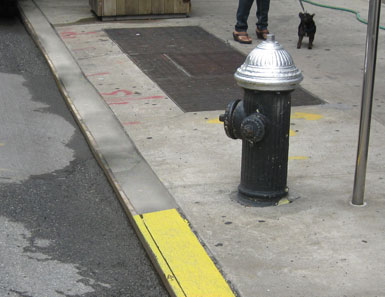3.7 Vault Approvals

This section describes the application and review process for obtaining approvals to construct or repair vaults under the sidewalks of New York City streets. NYC DOT issues permits for two types of vaults: building vaults and transformer vaults.
A building vault, as described in Section 2-13 of the Highway Rules, is any opening below the surface of the street that projects outside of the property line and is covered over, except for those openings: (1) used exclusively to access, by means of steps, the cellar or basement of any building; (2) used primarily for light and ventilation; (3) constructed or maintained by utility companies (including transformer vaults); and (4) which are subways, railroads and related structures.
A transformer vault is a subsurface structure or room that houses electrical transformers and appurtenant equipment. Transformer vaults are typically installed, owned and maintained by an electric utility company. The city has master revocable consent agreements with electric utility companies that allow them to occupy and use city property for transformer vaults.
The construction, alteration or repair of any building vault or transformer vault requires a permit from NYC DOT. Most vault work also requires plan approval and a permit from DOB. In some cases, approval from the LPC (if the vault is in an historic district) or the Metropolitan Transportation Authority (MTA) (if the vault is near a subway or tunnel entrance) is required. In addition, a vault license from NYC DOT's Office of Franchises, Concessions and Revocable Consents is required to construct a new building vault or enlarge an existing building vault.
Applications for NYC DOT vault permits are reviewed on a case-by-case basis. Applicants should contact the NYC DOT Plan Examination Unit (PEU) of the Permit Office to initiate the application process and to determine specific requirements for a permit and a license, if required. A list of the forms most commonly used during this process can be found in Appendix B, Forms. A $35 filing fee is required for all vault applications.
3.7.1 Building Vaults
PEU performs the initial review of all applications for building vault permits and licenses. A DOB-approved plan must be obtained and submitted to PEU with the application for a final approval and permit. Different from DOB, DOT plans requires 600 PSF live loads on all sidewalk doors, gratings, covers and vault structures.
If the applicant plans to construct a new vault or enlarge an existing vault, PEU will refer the applicant to NYC DOT's Office of Franchises, Concessions and Revocable Consents for a vault license. When the license is issued, the applicant must pay a one-time license fee of $2 per square foot. The applicant can also request a new vault license for an existing vault by submitting SCARA plans and make a one-time license fee of $2 per square foot.
PEU also accepts applications to abandon existing vaults that are no longer in use. NYC DOT may order a vault licensee or the owner of the premises where the vault is located to fill in an abandoned vault. Specific requirements for filling in abandoned vaults can be found in Section 2-13(o) of the Highway Rules. Typical treatments include removing vault roof near curb, filling flowable lifts, and breaking vault floor. DOB approval is also required.
3.7.2 Transformer Vaults
All applications for construction or repair of a transformer vault must be accompanied by an electric utility company layout, and must comply with the minimum clearance requirements for transformer vaults unless an approval or waiver is obtained from the appropriate agency or utility (more information is available in Appendix B, Forms). Contact PEU for further information regarding the procedure to obtain initial and final approval for a transformer vault.
3.7.3 Vaults Requiring a Revocable Consent
The construction of any vault that extends beyond the curb must be authorized under a revocable consent agreement, as required in Section 2-13(c) of the Highway Rules, in addition to approval by PEU. View more information and instructions for obtaining a revocable consent.